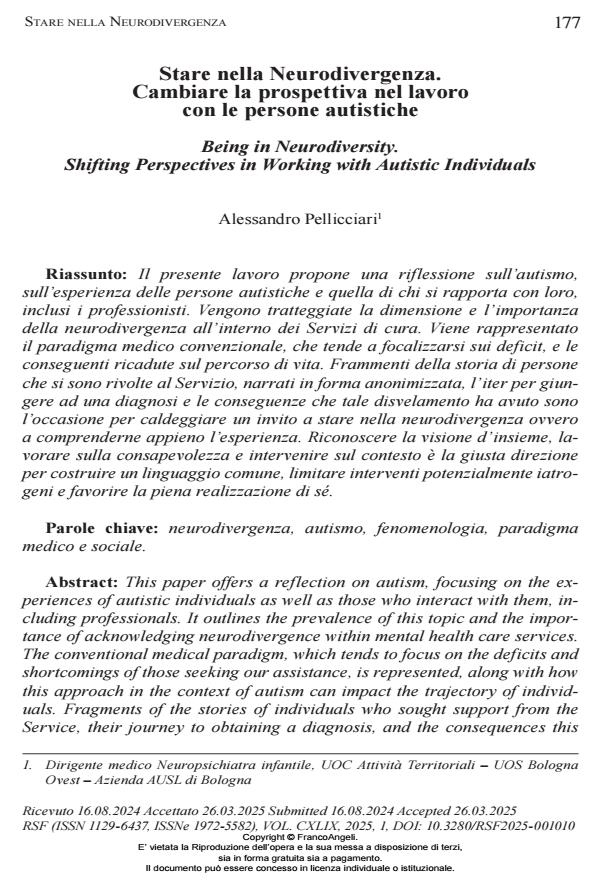Being in Neurodiversity. Shifting Perspectives in Working with Autistic Individuals
Journal title RIVISTA SPERIMENTALE DI FRENIATRIA
Author/s Alessandro Pellicciari
Publishing Year 2025 Issue 2025/1
Language Italian Pages 18 P. 177-194 File size 739 KB
DOI 10.3280/RSF2025-001010
DOI is like a bar code for intellectual property: to have more infomation
click here
Below, you can see the article first page
If you want to buy this article in PDF format, you can do it, following the instructions to buy download credits

FrancoAngeli is member of Publishers International Linking Association, Inc (PILA), a not-for-profit association which run the CrossRef service enabling links to and from online scholarly content.
This paper offers a reflection on autism, focusing on the experiences of autistic individuals as well as those who interact with them, including professionals. It outlines the prevalence of this topic and the importance of acknowledging neurodivergence within mental health care services. The conventional medical paradigm, which tends to focus on the deficits and shortcomings of those seeking our assistance, is represented, along with how this approach in the context of autism can impact the trajectory of individuals. Fragments of the stories of individuals who sought support from the Service, their journey to obtaining a diagnosis, and the consequences this revelation had on their lives, narrated in anonymized form, serve as an opportunity to advocate for embracing neurodivergence. This involves fully understanding these individuals’ experiences, recognizing the bigger picture in them, working on awareness, and intervening in the environment. These are valuable tools for building a common language, limiting potential harmful interventions, and fostering the self-fulfillment of the autistic individuals who come to us.
Keywords: neurodiversity, autism, phenomenology, medical and social models.
- [1.] Kanner, L. Autistic disturbances of affective contact. Nervous Child 1943; 2(3), 217-250.
- [2.] Harris, JC. The origin and natural history of autism spectrum disorders. Nature Neuroscience 2016; 19(11), 1390-1391. https://www.nimh.nih.gov/health/topics/autism-spectrum-disorders-asd#:~:text=Autism%20 is%20known%20as%20a,can%20be%20diagnosed%20with%20ASD Hacking I. Humans, aliens & autism. Dedalus 2009; 138 (3):44-59.
- [3.] Baxter AJ, Brugha TS, Erskine H, Scheurer RW, Vos T, Scott JG. The epidemiology and global burden of autism spectrum disorders. Psychological Medicine 2015; 45: 601-613.
- [4.] Office for National Statistics. Census 2021 Data and analysis from census 2021; Autism Prevalence, UK, 2020 Autism prevalence, UK, 2020-Office for National Statistics (ons.gov.uk): Office for National Statistics.
- [5.] Polyak A, Kubina RM, Girirajan S. Comorbidity of intellectual disability confounds ascertainment of autism: implications for genetic diagnosis. American Journal ofMedical Genetics Part B: Neuropsychiatric Genetics 2015; 168(7): 600-608.
- [6.] Camm-Crosbie L, Bradley L, Shaw R, Baron-Cohen S, Cassidy S. ’People like me don’t get support’: Autistic Adults’ experiences of support and treatment for mental health difficulties, self-injury and suicidality. Autism.2019; 23(6): 1431-41.
- [7.] Curnow E, Rutherford M, Maciver D, Johnston L, Prior S, Boilson M, et al. 2023 Mental health in autistic adults: A rapid review of prevalence of psychiatric disorders and umbrella review of the effectiveness of interventions within a neurodiversity informed perspective. PLoS One. 2023; 18(7), e0288275.
- [8.] Pellicano E, den Houting J. Annual research review: shifting from normal science to neurodiversity in autism science. The journal of child psychology and psychiatry. 2022; 63(4): 381-386. https://www.malattierare.gov.it/malattie/dettaglio/9983
- [9.] World Health Organisation 1980. International classification of impairments, disabilities, and handicaps.
- [10.] Lord C, Elsabbagh M, Baird G, Veenstra-Vanderweele J. Autism spectrum disorder. Lancet 2018; 392 (10146): 508-520.
- [11.] Glynne-Owen R. Early intervention and autism: the impact of positivism and the call for change. The journal of children’s rights 2010; 18(3): 405-416.
- [12.] Ne’eman A. When disability is defined by behavior, outcome measures should not promote “passing”. AMA journal of ethics. 2021; Jul 23 (7): E569-575.
- [13.] Singer J, ed. Neurodiversity, the birth of an idea. Editore Judy Singer, 2017.
- [14.] Chapman R, Botha M. Neurodivergence-informed therapy. Developmental medicine & Child Neurology, 2023; 65(3): 310-317.
- [15.] Hull L, Petrides KV, Allison C, Smith P, Baron-Cohen S, Lai MC, et al. ‘Putting on my best normal’: Social camouflaging in adults with autism spectrum conditions. Journal of Autism and Developmental Disorders. 2017; 47: 2519-2534.
- [16.] Ballerini A, Rossi Monti M. Le dicotomie psicopatologiche sono una specie in estinzione? Rivista Sperimentale di Freniatria. 1996; 120 (5Suppl): 1060-1066.
- [17.] Zeidan J, Fonbonne E, Scorah J et al. Global prevalence of autism, a sistematic review update. Autism research : official journal of the International Society for Autism Research. 2022; 15(5): 778-790.
Alessandro Pellicciari, Stare nella Neurodivergenza. Cambiare la prospettiva nel lavoro con le persone autistiche in "RIVISTA SPERIMENTALE DI FRENIATRIA" 1/2025, pp 177-194, DOI: 10.3280/RSF2025-001010